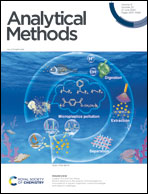Surface-enhanced Raman spectroscopy for rapid identification and quantification of Flibanserin in different kinds of wine†
Abstract
Wine has always been a popular carrier for psychedelic drugs, with the rapid identification and quantification of psychedelic drugs in wine being the focus of regulating illegal behavior. In this study, surface-enhanced Raman spectroscopy (SERS) is used for the rapid detection of Flibanserin in liquor, beer and grape wine. First, the theoretical Raman spectrum with characteristic Flibanserin peaks was calculated and identified, and the limit of detection of 1 μg mL−1 for Flibanserin in liquor was determined. The curve equation was obtained by fitting using the least squares method, and the correlation coefficient was 0.995. The recovery range of the Flibanserin liquor solution ranged from 93.70% to 108.32%, and the relative standard deviation (RSD) range was 2.77% to 7.81%. Identification and quantification of Flibanserin in liquor, beer and grape wine were done by principal component analysis (PCA) and support vector machine (SVM). Machine learning algorithms were used to reduce the workload and the possibility of manual misjudgements. The classification accuracies of the Flibanserin liquor, beer and grape wine spectra were 100.00%, 95.80% and 92.00%, respectively. The quantitative classification accuracies of the Flibanserin liquor, beer and grape wine spectra were 92.30%, 91.70% and 92.00%, respectively. The machine learning algorithms were used to verify the advantages and feasibility of this method. This study fully demonstrates the huge application potential of combining SERS technology and machine learning in the rapid on-site detection of psychedelic drugs.



 Please wait while we load your content...
Please wait while we load your content...